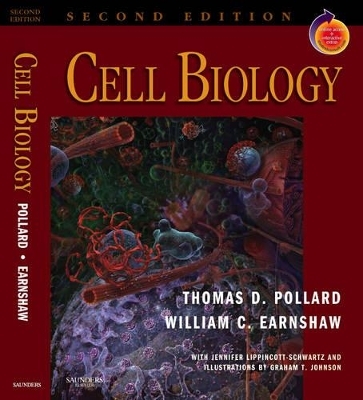
Cell Biology
Saunders
978-1-4160-2255-8 (ISBN)
- Titel ist leider vergriffen;
keine Neuauflage - Artikel merken
This book offers a masterful introduction to the cell biology that you need to know! This critically acclaimed text offers you a modern and unique approach to the study of cell biology. It emphasises that cellular structure, function, and dysfunction ultimately result from specific macromolecular interactions. You'll progress from an explanation of the "hardware" of molecules and cells to an understanding of how these structures function in the organism in both healthy and diseased states. The outstanding artwork helps you to better visualise molecular structures.
Thomas Dean Pollard is a prominent educator, cell biologist and biophysicist whose research focuses on understanding cell motility through the study of actin filaments and myosin motors. He is Sterling Professor of Molecular, Cellular & Developmental Biology and a Professor of Cell Biology and Molecular Biophysics & Biochemistry at Yale University. He was Dean of Yale's Graduate School of Arts and Sciences from 2010 to 2014, and President of the Salk Institute for Biological Studies from 1996 to 2001. Pollard is very active in promoting scientific education and research primarily through two major societies, both of which he is a past President: the American Society for Cell Biology and the Biophysical Society William Charles Earnshaw is Professor of Chromosome Dynamics at the University of Edinburgh where he has been a Wellcome Trust Principal Research Fellow since 1996. Earnshaw is an elected Fellow of the Royal Society since 2013 for his studies of mitotic chromosome structure and segregation. Before Edinburgh, he was Professor of Cell Biology and Anatomy at Johns Hopkins School of Medicine. Jennifer Lippincott-Swartz is Group Leader at the Howard Hughes Medical Institute Janelia Research Campus. Her lab uses live cell imaging approaches to analyze the spatio-temporal behaviour and dynamic interactions of molecules in cells with a special focus on neurobiology. Before Janelia, Lippincott-Swartz was a primary investigator and chief of the Section on Organelle Biology in the Cell Biology and Metabolism Branch. Her work there included a collaboration with physicists Eric Betzig and Harald Hess (now group leaders at Janelia), who proposed a new function for the photoactivatable protein. The scientists used the protein to generate photoactivatable fluorophores, or dyes, which enabled them to illuminate different sets of molecules sequentially, creating a microscope image far more detailed than previously possible. The method, called super-resolution microscopy, garnered Betzig the 2014 Nobel Prize in Chemistry.
SECTION I: Introduction to Cell Biology CHAPTER 1 Introduction to Cells CHAPTER 2 Evolution of Life on Earth SECTION II: Chemical and Physical Background CHAPTER 3 Molecules: Structures and Dynamics CHAPTER 4 Biophysical Principles CHAPTER 5 Macromolecular Assembly CHAPTER 6 Research Strategies SECTION III: Membrane Structure and Function CHAPTER 7 Membrane Structure and Dynamics CHAPTER 8 Membrane Pumps CHAPTER 9 Membrane Carriers CHAPTER 10 Membrane Channels CHAPTER 11 Membrane Physiology SECTION IV: Chromatin, Chromosomes, and the Cell Nucleus CHAPTER 12 Chromosome Organization CHAPTER 13 DNA Packaging in Chromatin and Chromosomes CHAPTER 14 Nuclear Structure and Dynamics SECTION V: Central Dogma: From Gene to Protein CHAPTER 15 Gene Expression This chapter was written by Jeffrey L. Corden CHAPTER 16 Eukaryotic RNA Processing This chapter was written by David Tollervey CHAPTER 17 Protein Synthesis and Folding SECTION VI: Cellular Organelles and Membrane Trafficking CHAPTER 18 Posttranslational Targeting of Proteins CHAPTER 19 Mitochondria, Chloroplasts, Peroxisomes CHAPTER 20 Endoplasmic Reticulum CHAPTER 21 Secretory Membrane System and Golgi Apparatus CHAPTER 22 Endocytosis and the Endosomal Membrane System CHAPTER 23 Degradation of Cellular Components SECTION VII Signaling Mechanisms CHAPTER 24 Plasma Membrane Receptors CHAPTER 25 Protein Hardware for Signaling CHAPTER 26 Second Messengers CHAPTER 27 Integration of Signals SECTION VIII: Cellular Adhesion and the Extracellular Matrix CHAPTER 28 Cells of the Extracellular Matrix and Immune System CHAPTER 29 Extracelluar Matrix Molecules CHAPTER 30 Cellular Adhesion CHAPTER 31 Intercellular Junctions CHAPTER 32 Connective Tissues SECTION IX: Cytoskeleton and Cellular Motility CHAPTER 33 Actin and Actin-Binding Proteins CHAPTER 34 Microtubules and Centrosomes CHAPTER 35 Intermediate Filaments CHAPTER 36 Motor Proteins CHAPTER 37 Intracellular Motility CHAPTER 38 Cellular Motility CHAPTER 39 Muscles SECTION X: Cell Cycle CHAPTER 40 Introduction to the Cell Cycle CHAPTER 41 G1 Phase and Regulation of Cell Proliferation CHAPTER 42 S Phase and DNA Replication CHAPTER 43 G2 Phase and Control of Entry into Mitosis CHAPTER 44 Mitosis and Cytokinesis CHAPTER 45 Meiosis CHAPTER 46 Programmed Cell Death Glossary Index
| Erscheint lt. Verlag | 18.4.2007 |
|---|---|
| Zusatzinfo | Approx. 500 illustrations |
| Verlagsort | Philadelphia |
| Sprache | englisch |
| Maße | 216 x 276 mm |
| Gewicht | 2504 g |
| Themenwelt | Medizin / Pharmazie ► Medizinische Fachgebiete |
| Naturwissenschaften ► Biologie ► Genetik / Molekularbiologie | |
| Naturwissenschaften ► Biologie ► Humanbiologie | |
| Naturwissenschaften ► Biologie ► Zellbiologie | |
| ISBN-10 | 1-4160-2255-4 / 1416022554 |
| ISBN-13 | 978-1-4160-2255-8 / 9781416022558 |
| Zustand | Neuware |
| Informationen gemäß Produktsicherheitsverordnung (GPSR) | |
| Haben Sie eine Frage zum Produkt? |
aus dem Bereich



